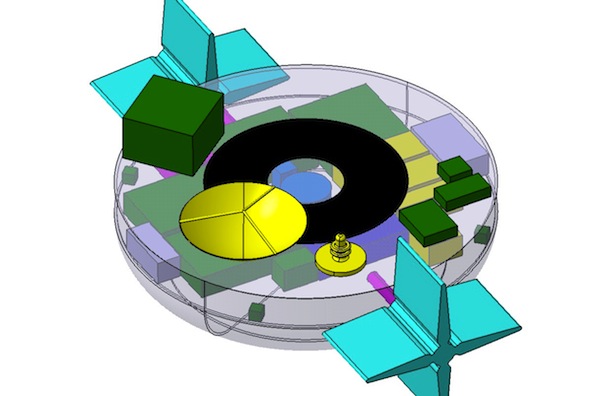Please note: Osher Rainforest will be closed for maintenance Jan. 14–16.
Science News
Sailing the Seas of Titan
October 10, 2012
by Zuberoa Marcos

(Scroll down for Spanish version)
Humanity has landed several rovers on Mars. The next scientific challenge is to land a boat on Titan.
Titan, Saturn’s largest moon, is one of the most interesting destinations in the Solar System for scientists looking for extraterrestrial life. Discovered on March 25, 1655 by the Dutch astronomer Christian Huygens, Titan has the most Earth-like atmosphere. Just as on Earth, it is composed primarily of nitrogen (95%), methane (approximately 3%), and the remaining 2% percent consists of hydrogen, little vapor water, other hydrocarbons and possibly argon. These atmospheric gases are some of the necessary building blocks for life.
In 2005, the Cassini-Huygens mission studied extensively Titan descending via parachute onto its mysterious surface. It confirmed that lakes, seas and rivers exist and cover much of the satellite’s northern hemisphere. However, the chemical composition of the lakes of Titan is still not well determined.
The Titan Lake In-situ Sampling Propelled Explorer (TALISE) project proposes sending a boat-probe to Saturn’s largest moon that could be propelled by paddles, inflatable wheels or screws. The probe would land in the middle of Ligeia Mare—Titan’s biggest lake and then sail for the coast, taking scientific measurements along the way.
“The detection of additional compounds and the investigation of the influence of both photochemistry and the atmosphere on the chemical composition of liquids of Titan’s lakes it is the next step to understand the satellite’s environment, its relationship with the climate and to analyze the possibility of prebiotic compounds” explained the scientists in the abstract of the project presented in the European Planetary Sciences Congress held in Madrid, Spain last month.
The TALISE project is currently being developed in Spain by SENER, an engineering company, and the Centro de Astrobiología, a research center associated with NASA’s Astrobiology Institute. The hovercraft design is still under consideration but they hope to be ready for a future space science mission call for proposals.
Zuberoa Marcos is a former biologist and current science writer based in Barcelona. She writes articles regularly for Science Today.
Surcando los mares de Titán
Por Zuberoa Marcos
La Humanidad ha posado varios rovers sobre la superficie de Marte. El próximo reto científico es que un barco se pose en Titán.
Titán, la luna más grande de Saturno, es uno de los destinos más interesantes del Sistema Solar para los científicos que buscan vida extraterrestre. Descubierto el 25 de marzo 1655 por el astrónomo holandés Christian Huygens, Titán tiene la atmósfera más parecida a la de la Tierra. Al igual que la de nuestro planeta, se compone principalmente de nitrógeno (95%), aproximadamente el 3% es metano y el 2% restante una mezcla de hidrógeno, vapor de agua, otros hidrocarburos y posiblemente argón. Todo estos gases atmosféricos son ladrillos necesarios para construir vida.
En 2005, la misión Cassini-Huygens estudió minuciosamente Titan al descender en paracaídas y posarse en su superficie. Confirmó que un conjunto de lagos, mares y ríos cubren gran parte del hemisferio norte del satélite. Sin embargo, la composición química de los lagos de Titán sigue siendo desconocida.
El proyecto Explorador in situ de los lagos de Titán (TALISE por sus siglás en inglés) propone enviar un barco-sonda propulsado por paletas o ruedas inflables a la luna más grande de Saturno. La sonda aterrizaría en medio del Ligeia Mare, el lago más grande de Titán, y después navegaría por la costa realizando mediciones científicas a lo largo del camino.
"La detección de compuestos químicos adicionales y el estudio de la influencia de la fotoquímica y de la atmósfera en la composición química de los líquidos que forman los lagos de Titán es el siguiente paso para comprender el medioambiente del satélite, su clima y analizar la posible existencia de compuestos prebióticos", explicaron los científicos en el resumen del proyecto presentado en el Congreso Europeo de Ciencias Planetarias celebrado en Madrid, España, el pasado mes de septiembre.
El proyecto TALISE está siendo desarrollado por la empresa española de ingeniería SENER y el Centro de Astrobiología, un centro de investigación asociado al Instituto de Astrobiología de la NASA y ubicado en las afueras de Madrid. El diseño del barco está aún en estudio, pero los científicos confían en tenerlo listo para la próxima convocatoria de propuestas para futuras misiones espaciales.
Zuberoa Marcos es bióloga molecular y actualmente trabaja como productora de TV y periodista científica. Escribe de forma regular para Science Today.